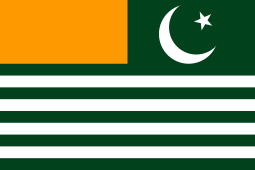Mirpur district
| Mirpur ضلع میر پور | ||
|---|---|---|
| district | ||
| ||
| Coordinates: 33°08′57″N 73°45′12″E / 33.1491°N 73.7534°ECoordinates: 33°08′57″N 73°45′12″E / 33.1491°N 73.7534°E | ||
| Country | Pakistan | |
| Established | 1947 | |
| Headquarters | Mirpur | |
| Area | ||
| • Total | 1,010 km2 (390 sq mi) | |
| Population | ||
| • Total | 745,000 | |
| Time zone | PST (UTC+5) | |
Mirpur district (Urdu: ضلع میر پور) is a district in Azad Kashmir.[1] The district is named after the main city, Mirpur. The district of Mirpur has a population of 371,000 and covers an area of 1,010 km2 (390 sq mi).[1] The district is mainly mountainous with some plains. Its hot, dry climate and other geographical conditions closely resemble those of Jhelum and Gujrat, the adjoining districts of Pakistan.
History
During the British colonial times, Mirpur was one of the five districts of the Jammu province in the princely state of Jammu and Kashmir.[2][3] It consisted of three tehsils: Kotli, Mirpur and Bhimber.[4] Kotli and Bhimber have since been made into separate districts. According to the 1941 census, the original district had a population of 386,655, roughly 80% of whom were Muslim and 16% were Hindu.[5] The Mirpur district, along wih the districts of Poonch and Reasi, had close geographic, ethnic and cultural connections with West Punjab, more so than with the Jammu city and the rest of the Jammu province. The people of Mirpur therefore had a strong desire to join Pakistan.[6]
Language
The people of the Mirpur district (along with Kotli and Bhimber) speak a language called "Mirpuri" or "Pahari", which is a blend of Punjabi, Dogri, Pothowari, Lahndi, and Gojri. Mirpuri itself is not officially recognized as an independent language. It is generally called "Mirpuri Pahari," "Mirpuri Pothowari" or "Mirpuri Punjabi".[7]
The vast majority belong to the Jatt ethnic group followed by Rajputs and Gujjars. The rest were lower caste people known as massalis up to the 1950s.[8] They included artisans like nais, mistrys, tarkhans, chamars, mochis, telis and others. These groups eventually left their massalin Mirpuri Potohari; the Majh and Gojri dialects of Punjabi Language are now the predominant languages of the district. Other languages spoken include Urdu and English.
Government


Mirpur District is located in southwestern Kashmir, and west of the Jammu province. It is part of Pakistan-administered Kashmir, which comes under the protection of Pakistan. Part of Jammu is currently managed by India. Both countries are currently in dispute as to which country owns Jammu and Kashmir. The district is administratively subdivided into two tehsils:
Tourism
- Islamgarh (town)
Located 30 km from Mirpur - comes between Chaksawari and Kakra. it's distance will be 7 km after completed of Rathoa Haryam Bridge
- Kakra (town) - Located 12 km from Mirpur - comes between Mirpur and Islamgarh.
- Khari Sharif - located 8 km from Mirpur; it
is famous for its Sufi shrines.
- Mangla, a town 16 km from Mirpur; it is situated at the mouth of the Mangla Dam.
- Rajoa
- Ramkot Fort
- Sahalia
Education
According to the Alif Ailaan Pakistan District Education Rankings 2015, Mirpur is ranked 13 out of 148 districts in terms of education. For facilities and infrastructure, the district is ranked 87 out of 148.[9]
Refugees
Erstwhile Mirpur District (including present-day Bhimber District) has a considerable refugee population (like refugees in Karachi) They are from almost all the castes; however, Mirpur (especially Tehsil Dadyal) has predominantly Jat and Gujjar caste refugees. The villages of Jat refugees in Tehsil Dadyal are Mohra Kanyal, Malkan and Mehndir Colony. A vast majority from Mohra Malkan has shifted to Village Khairowal Jattan, Tehsil Barnala, Distt Bhimber in 1974 where each family was allotted 64 Kanals of agricultural land. However, many of the families which shifted to Khairowal or Chamb still have nostaligic feelings of their days in Dadyal and great people of Dadyal. They do not miss an opportunity (funeral, weddings, festivals) to enjoy their occasional reunions with the inhabitants of Mohra Malkan and other nearby villages like Chapran, Mehra etc.
Villages
- Mirpur tehsil
Afzalpur, Abdulahpur, Andrah Kalan, Arah Jagir, Ballah,Pakhral, Banni, Bongdawara, Burjan, Chabrian Dattan, Chak Haryam, Chandral, Chatan, Chechian, Chitterpari, Dalyala, Dheri Thothal, Rathoa, Ghaseetpur Awan, Ghaseetpur Sohalian, Islamgarh, Mora Rakhyal Mora Loharan, Mora Rathyan, Mankarah, New City', Tariq Abad„ Jatlan, Jangian Kotla, Kakra, Kalyal Bhainsi, Kas Kalyal, Khari Sharif, Khokhar, Mehmunpur, Mori, Nagial, Pindi Subherwal, Potha Bainsi, Sahang, Saleemabad, SukhChainPur, Nawan Garan, Gorsian, Chak Ghayan, Raipur.
- Dadyal tehsil
Amb, Chattroh, Haveli Baghal, Kathar Dilawar, Mandi, Mohra Malkan, Mohra Sher Shah, Rajoa, Ratta, Sahalia, Siakh Pahaith, Thalarajwali Khan, Thub Jagir, Ankar Raajgan.
References
- 1 2 - Government Website
- ↑ Karim, Kashmir The Troubled Frontiers 2013, pp. 29-32.
- ↑ Behera, Demystifying Kashmir 2007, p. 15.
- ↑ Snedden 2001, p. 112.
- ↑ Snedden 2001, p. 118.
- ↑ Snedden 2001, p. 120.
- ↑ Bhatti, Muhammad Rafiq (2013), "Language, Culture and Heritage of Mirpur", Himalayan and Central Asian Studies, 17 (1): 33–43
- ↑ Pakistan's caste system: The untouchable's struggle, The Express Tribune, 31 March 2012.
- ↑ "Individual district profile link, 2015". Alif Ailaan. Retrieved 2015-05-06.
Bibliography
- Behera, Navnita Chadha (2007), Demystifying Kashmir, Pearson Education India, ISBN 8131708462
- Karim, Maj Gen Afsir (2013), Kashmir The Troubled Frontiers, Lancer Publishers LLC, pp. 29–32, ISBN 978-1-935501-76-3
- Snedden, Christopher (2001), "What happened to Muslims in Jammu? Local identity, ‘"the massacre” of 1947’ and the roots of the ‘Kashmir problem’", South Asia: Journal of South Asian Studies, 24 (2): 111–134, doi:10.1080/00856400108723454
- Snedden, Christopher (2013) [first published as The Untold Story of the People of Azad Kashmir, 2012], Kashmir: The Unwritten History, HarperCollins India, ISBN 9350298988
